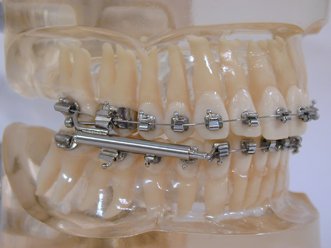The SUS is a fixed brace used for the treatment of overbite in the lower jaw. The letters SUS actually stand for’ Sabbagh Universal Spring’ as the device is named after its inventor A. Sabbagh. It consists of two telescopic attachments which are fixed to a bracket brace (MB-appliance) and, once inserted, it immediately brings the lower jaw forwards. It restricts neither forward nor sideward movement of the jaw and also allows the mouth to open fully, but SUS just prevents the lower jaw from moving backwards. If we look at this appliance closely we could say that it not only resembles the Herbst-Appliance but actually is a Herbst-Appliance. However, it is easier to use than the original. The original one is actually cemented to the teeth by two large metal cap splints and allows for no movement of individual teeth. Skillful use of Herbst clones such as the SUS can significantly shorten the treatment duration and also make the treatment more effective.
Effect
The SUS Spring works just like an Activator that is worn for 24 hours a day, only it is even better because an Activator is actually only effective when the mouth is closed whereas a SUS Spring (or any other Herbst-clone) works continuously. This is the reason why most lower-jaw overbite problems that occur in adolescence can be corrected within nine months. So the SUS normally works within a fraction of the time that it takes for the slow and often deficient Activator to work. This makes it a very effective brace. As is the case with the Herbst and other ‘functional orthopedic’ double braces, the effect of the SUS comes from the movement of the teeth rather than from any influence on growth. The minor skeletal changes gradually disappear again within a few years of treatment so, in the long term, not even the SUS Spring can bring about any significant lengthening of the lower jaw.
Advantages
An extremely effective brace, requires no patient cooperation, cheaper than a Herbst-Scharnier, short treatment time
Disadvantages
Often needs repair, brackets often break, needs a lot of medical time and is uncomfortable to wear for some patients.

